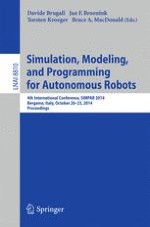2014 | Buch
Simulation, Modeling, and Programming for Autonomous Robots
4th International Conference, SIMPAR 2014, Bergamo, Italy, October 20-23, 2014. Proceedings
herausgegeben von: Davide Brugali, Jan F. Broenink, Torsten Kroeger, Bruce A. MacDonald
Verlag: Springer International Publishing
Buchreihe : Lecture Notes in Computer Science
